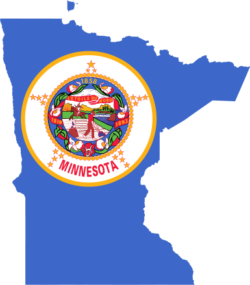

*The map and data in the table are from Wikipedia. The categories include such records as property records, vital records, licensing records, crime records, and more, and can be searched by specific record type.

The below list of available public records for the state of Minnesota are sorted by category. It is also home to the nation’s largest shopping mall, Bloomington’s Mall of America.

The state is currently among one of the best educated and wealthiest in the nation. In 2008, 33 of the top 1,000 publicly traded companies in the U.S. The state’s manufacturing sector includes technology and biomedical firms. Minnesota’s economy has transformed to finished products and services in addition to agriculture. It is also a large producer of corn and soybeans. Minnesota is the largest producer of sugar beets, sweet corn, green peas and turkeys in the U.S. Minnesota’s population gradually shifted from rural areas to cities during the 20th century. The iron was shipped by rail and then loaded onto ships and transported eastward. With the discovery of iron ore in the 1880s, the state’s iron-mining industry was established. Minnesota’s early economy was based on logging and farming. The two cities and their metropolitan areas are known as the “Twin Cities,” and are home to 60% of the state’s population. The capital of the state is Saint Paul and it lies adjacent to the city of Minneapolis, the state’s largest city.

There are 17 cities in Minnesota with populations above 50,000. The population of Minnesota is estimated at 5,489,594, making it the 22nd most populated state. It also currently has America’s largest Somali population outside of East Africa. The state remains a center of Scandinavian and German culture. During the 19th and 20th centuries, a large number of European settlers from Scandinavia and Germany entered the state. The Minnesota Territory was formed on March 3, 1849. Land west of the Mississippi River was acquired with the Louisiana Purchase. at the end of the American Revolutionary War. The portion of the state east of the Mississippi River became part of the U.S. As the east coast was settled by the Europeans, Native American tribes moved into the Minnesota area. Minnesota was populated by a subculture of the Sioux Tribe called the Dakota before the European settlement of North America. It has 72 state parks and recreation areas, 58 state forests and numerous state wildlife preserves. Itasca State Park, established in 1891, is Minnesota’s first state park. The state’s high point is Eagle Mountain at 2,301 feet which is only 13 miles away from the low of 601 feet at the shore of Lake Superior. It experiences rain, snow, blizzards, thunderstorms, hail, tornadoes and high-velocity straight-line winds. The climate in Minnesota is characteristic of cold winters and hot summers. Minnesota has approximately 10.6 million acres of wetlands within its borders, the most of any state except Alaska. The Mississippi River begins its journey from the headwaters at Lake Itasca. The state’s large number of lakes gives Minnesota its nickname as the “Land of 10,000 Lakes.” Minnesota also has 6,564 natural rivers and streams. Much of Minnesota is gently rolling hills with 11,842 lakes over 10 acres in size. Minnesota shares a Lake Superior water border with Michigan and a land and water border with Wisconsin to the east, Iowa to the south, North Dakota and South Dakota to the west and the Canadian provinces of Ontario and Manitoba to the north. Minnesota is the northernmost contiguous state. One of the states in the Great Lakes region of the United States is the state of Minnesota.


 0 kommentar(er)
0 kommentar(er)
